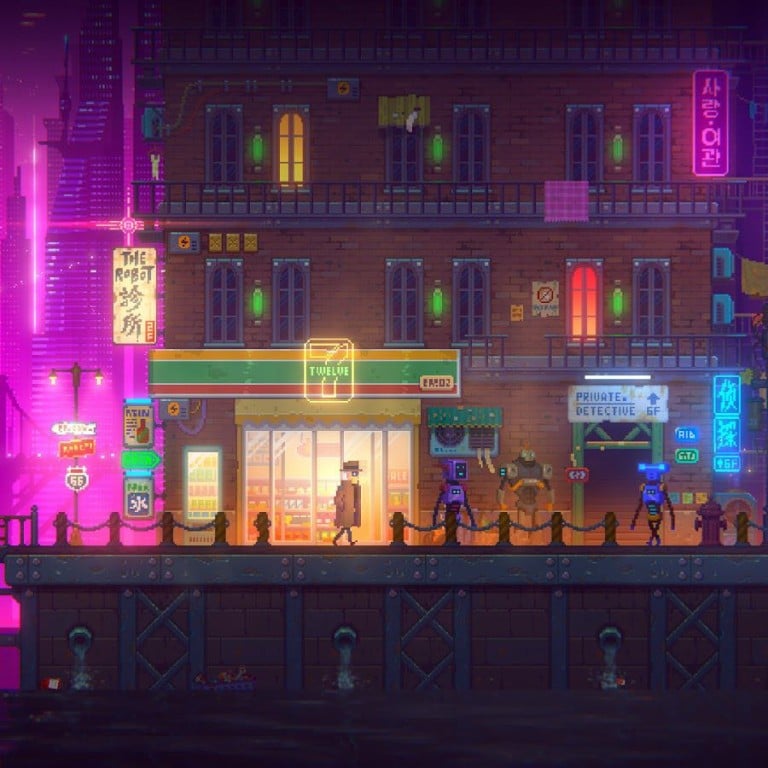
Tales of the Neon Sea is a beautiful but slow cyberpunk puzzle game
The pixel art is vibrant and detailed, but the puzzles are uninspired
Take a cyberpunk world, paint it in the style of exquisitely crafted pixel art, then throw in some neo-noir detective motifs and you get Tales of the Neon Sea. The new detective puzzle game from Chinese developer Palm Pioneer has almost all the right ingredients for an arresting experience.
All the game really needs now is an engrossing story.
That doesn’t help with where the game stands now, though. While I was left with the feeling of wanting to be more immersed in the game’s gorgeous world, I also felt unfulfilled after I was dragged through a bunch of uninspiring puzzles without delivering any meaningful payoff.
All things considered, Tales of the Neon Sea is a beautiful puzzle game, but it’s also a missed opportunity. Given the game's conventional selection of puzzles, it feels much more like a traditional puzzle game than the eye-opening adventure it’s presented as.

That said, the game does start off with an interesting hook. You find yourself waking up in the sewage as a wounded cyborg detective, with scythe-carrying Death trailing close behind. You then narrowly escape Death and scavenge spare parts to patch yourself up. As you undergo reparation, the game takes you back to the very beginning.
In the main story line, you play as a ex-spec-ops-turned-private-detective who lives in a world inhabited by both humans and robots. Robots still mostly act as human servants, but the political winds are changing and a robot liberation movement is brewing.
You are then introduced to a new case involving the brutal murder of a wealthy elderly woman. After collecting clues at the crime scene, you find that your primary suspects are the daughter of "an important man" and the victim's own robot butler whose brain is implanted with a foreign device. So off you embark on a journey to unravel the mystery.
Sounds interesting, right? The premise of the story is captivating, but much of this exciting narrative gets bogged-down by too many conventional puzzles that usually involve something geometric or sequential. A typical puzzle in the game might be to align the circuitry on a board that is divided into many blocks. You will have to rotate these blocks until certain wires are connected.
Many of these puzzles feel like classic video game tropes that are a dime a dozen in the puzzle game genre. Occasionally, though, you’ll get some memorable sequences. In one part of the game I had to pick apart the robot butler's skull layer by layer through solving different puzzles.
But overall the puzzles are not the most imaginative. Even though puzzles don’t really repeat in the game, you’ll notice many of them can feel very similar.
In addition to puzzles, the game also asks you to do a several banal favors for the non-player characters. For example, in order to get into the Rainbow Club, you will have to help the manager get his showgirls back to work. Persuading the women requires completing trivial tasks like finding a music box for one of them.
The tasks may not be very exciting, but interactions with the NPCs are actually highlight of the game. These characters push you to further explore the game’s highly-detailed world. Some NPCs also have interesting and quirky personalities. Since the tasks feel hackneyed, though, and the rewards are anticlimactic, they don’t feel like engaging adventures.

Overall, repetitive puzzles and time-killing sequences make the game feel poorly paced. While it gets off to a strong start, the game eventually feels like it’s just dragging along.
Disappointing gameplay aside, Neon Sea does shine in other areas. The visuals are the game’s biggest selling point. While the in-game environment adopts a pixel art aesthetic, characters have an edgier comic book style when they appear with a dialogue box. Both styles are a pleasure to look at.
When it comes to the in-game environment, which is colored with a lively neon purple palette, it looks like every object is carefully drawn. While the pixel art style has become a bit ubiquitous these days, Neon Sea stands out with an impressive cyberpunk style in its cityscape.
Speaking of The Godfather, the film is referenced in my favorite part of the game. In this part, I got to play as the detective's cat, who has to infiltrate a street cat gang under threat from a rival gang of biocats. Many cats have names straight out of The Godfather. It is hilarious to be conversing with the smug cat versions of Tessio, Paulie and Connie. However, as good as this set piece is, it doesn't really help progress the main plot, making it a lot less satisfying than it could have been.

All in all, Tales of the Neon Sea is a pretty game with a lot of potential that it fails to live up to. In the game’s current form, the beautiful art is blighted by mediocre game design and terrible pacing.
For more insights into China tech, sign up for our tech newsletters, subscribe to our Inside China Tech podcast, and download the comprehensive 2019 China Internet Report. Also roam China Tech City, an award-winning interactive digital map at our sister site Abacus.

